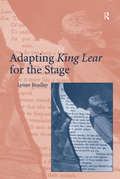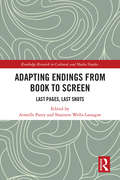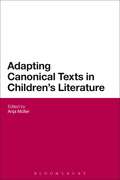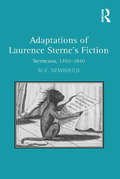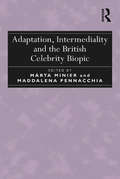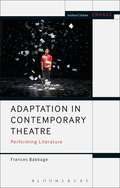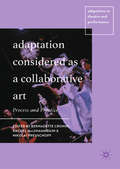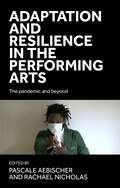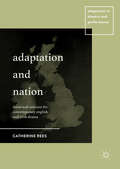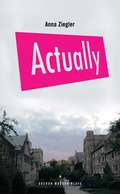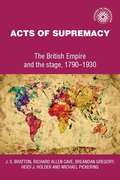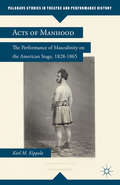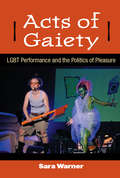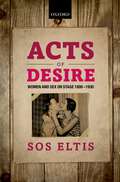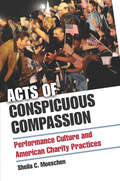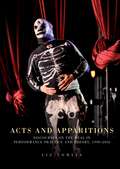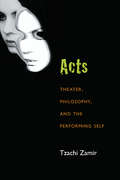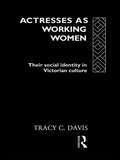- Table View
- List View
Adapting King Lear for the Stage
by Lynne BradleyQuestioning whether the impulse to adapt Shakespeare has changed over time, Lynne Bradley argues for restoring a sense of historicity to the study of adaptation. Bradley compares Nahum Tate's History of King Lear (1681), adaptations by David Garrick in the mid-eighteenth century, and nineteenth-century Shakespeare burlesques to twentieth-century theatrical rewritings of King Lear, and suggests latter-day adaptations should be viewed as a unique genre that allows playwrights to express modern subject positions with regard to their literary heritage while also participating in broader debates about art and society. In identifying and relocating different adaptive gestures within this historical framework, Bradley explores the link between the critical and the creative in the history of Shakespearean adaptation. Focusing on works such as Gordon Bottomley's King Lear's Wife (1913), Edward Bond's Lear (1971), Howard Barker's Seven Lears (1989), and the Women's Theatre Group's Lear's Daughters (1987), Bradley theorizes that modern rewritings of Shakespeare constitute a new type of textual interaction based on a simultaneous double-gesture of collaboration and rejection. She suggests that this new interaction provides constituent groups, such as the feminist collective who wrote Lear's Daughters, a strategy to acknowledge their debt to Shakespeare while writing against the traditional and negative representations of femininity they see reflected in his plays.
Adapting Endings from Book to Screen: Last Pages, Last Shots (Routledge Research in Cultural and Media Studies)
by Armelle Parey Shannon Wells-LassagneThis book offers a new perspective on adaptation of books to the screen; by focusing on endings, new light is shed on this key facet of film and television studies. The authors look at a broad range of case studies from different genres, eras, countries and formats to analyse literary and cinematic traditions, technical considerations and ideological issues involved in film and television adaptions. The investigation covers both the ideological implications of changes made in adapting the final pages to the screen, as well as the aesthetic stance taken in modifying (or on the contrary, maintaining) the ending of the source text. By including writings on both film and television adaptations, this book examines the array of possibilities for the closure of an adapted narrative, focusing both on the specificities of film and different television forms (miniseries and ongoing television narratives) and at the same time suggesting the commonalities of these audiovisual forms in their closing moments. Adapting Endings from Book to Screen will be of interest to all scholars working in media studies, film and television studies, and adaptation studies.
Adapting Endings from Book to Screen: Last Pages, Last Shots (Routledge Research in Cultural and Media Studies)
by Shannon Wells-Lassagne Armelle PareyThis book offers a new perspective on adaptation of books to the screen; by focusing on endings, new light is shed on this key facet of film and television studies. The authors look at a broad range of case studies from different genres, eras, countries and formats to analyse literary and cinematic traditions, technical considerations and ideological issues involved in film and television adaptions. The investigation covers both the ideological implications of changes made in adapting the final pages to the screen, as well as the aesthetic stance taken in modifying (or on the contrary, maintaining) the ending of the source text. By including writings on both film and television adaptations, this book examines the array of possibilities for the closure of an adapted narrative, focusing both on the specificities of film and different television forms (miniseries and ongoing television narratives) and at the same time suggesting the commonalities of these audiovisual forms in their closing moments. Adapting Endings from Book to Screen will be of interest to all scholars working in media studies, film and television studies, and adaptation studies.
Adapting Canonical Texts in Children's Literature
by Anja MüllerAdaptations of canonical texts have played an important role throughout the history of children's literature and have been seen as an active and vital contributing force in establishing a common ground for intercultural communication across generations and borders. This collection analyses different examples of adapting canonical texts in or for children's literature encompassing adaptations of English classics for children and young adult readers and intercultural adaptations of children's classics across Europe. The international contributors assess both historical and transcultural adaptation in relation to historically and regionally contingent concepts of childhood. By assessing how texts move across age-specific or national borders, they examine the traces of a common literary and cultural heritage in European children's literature.
Adapting Canonical Texts in Children's Literature
by Anja MüllerAdaptations of canonical texts have played an important role throughout the history of children's literature and have been seen as an active and vital contributing force in establishing a common ground for intercultural communication across generations and borders. This collection analyses different examples of adapting canonical texts in or for children's literature encompassing adaptations of English classics for children and young adult readers and intercultural adaptations of children's classics across Europe. The international contributors assess both historical and transcultural adaptation in relation to historically and regionally contingent concepts of childhood. By assessing how texts move across age-specific or national borders, they examine the traces of a common literary and cultural heritage in European children's literature.
Adaptations of Laurence Sterne's Fiction: Sterneana, 1760–1840
by Mary-Celine NewbouldExploring how readers received and responded to literary works in the long eighteenth century, M-C. Newbould focuses on the role played by Laurence Sterne’s fiction and its adaptations. Literary adaptation flourished throughout the eighteenth century, encouraging an interactive relationship between writers, readers, and artists when well-known works were transformed into new forms across a variety of media. Laurence Sterne offers a particularly dynamic subject: the immense interest provoked by The Life and Opinions of Tristram Shandy, Gentleman and A Sentimental Journey through France and Italy inspired an unrivalled number and range of adaptations from their initial publication onwards. In placing her examination of Sterneana within the context of its production, Newbould demonstrates how literary adaptation operates across generic and formal boundaries. She breaks new ground by bringing together several potentially disparate aspects of Sterneana belonging to areas of literary studies that include drama, music, travel writing, sentimental fiction and the visual. Her study is a vital resource for Sterne scholars and for readers generally interested in cultural productivity in this period.
Adaptations of Laurence Sterne's Fiction: Sterneana, 1760–1840
by Mary-Celine NewbouldExploring how readers received and responded to literary works in the long eighteenth century, M-C. Newbould focuses on the role played by Laurence Sterne’s fiction and its adaptations. Literary adaptation flourished throughout the eighteenth century, encouraging an interactive relationship between writers, readers, and artists when well-known works were transformed into new forms across a variety of media. Laurence Sterne offers a particularly dynamic subject: the immense interest provoked by The Life and Opinions of Tristram Shandy, Gentleman and A Sentimental Journey through France and Italy inspired an unrivalled number and range of adaptations from their initial publication onwards. In placing her examination of Sterneana within the context of its production, Newbould demonstrates how literary adaptation operates across generic and formal boundaries. She breaks new ground by bringing together several potentially disparate aspects of Sterneana belonging to areas of literary studies that include drama, music, travel writing, sentimental fiction and the visual. Her study is a vital resource for Sterne scholars and for readers generally interested in cultural productivity in this period.
Adaptation, Intermediality and the British Celebrity Biopic
by Márta Minier Maddalena PennacchiaBeginning with the premise that the biopic is a form of adaptation and an example of intermediality, this collection examines the multiplicity of 'source texts' and the convergence of different media in this genre, alongside the concurrent issues of fidelity and authenticity that accompany this form. The contributors focus on big and small screen biopics of British celebrities from the late twentieth and twenty-first centuries, attending to their myth-making and myth-breaking potential. Related topics are the contemporary British biopic's participation in the production and consumption of celebrated lives, and the biopic's generic fluidity and hybridity as evidenced in its relationship to such forms as the bio-docudrama. Offering case studies of film biographies of literary and cultural icons, including Elizabeth I, Elizabeth II, Diana Princess of Wales, John Lennon, Shakespeare, Jane Austen, Beau Brummel, Carrington and Beatrix Potter, the essays address how British identity and heritage are interrogated in the (re)telling and showing of these lives, and how the reimagining of famous lives for the screen is influenced by recent processes of manufacturing celebrity.
Adaptation, Intermediality and the British Celebrity Biopic
by Márta Minier Maddalena PennacchiaBeginning with the premise that the biopic is a form of adaptation and an example of intermediality, this collection examines the multiplicity of 'source texts' and the convergence of different media in this genre, alongside the concurrent issues of fidelity and authenticity that accompany this form. The contributors focus on big and small screen biopics of British celebrities from the late twentieth and twenty-first centuries, attending to their myth-making and myth-breaking potential. Related topics are the contemporary British biopic's participation in the production and consumption of celebrated lives, and the biopic's generic fluidity and hybridity as evidenced in its relationship to such forms as the bio-docudrama. Offering case studies of film biographies of literary and cultural icons, including Elizabeth I, Elizabeth II, Diana Princess of Wales, John Lennon, Shakespeare, Jane Austen, Beau Brummel, Carrington and Beatrix Potter, the essays address how British identity and heritage are interrogated in the (re)telling and showing of these lives, and how the reimagining of famous lives for the screen is influenced by recent processes of manufacturing celebrity.
Adaptation in Contemporary Theatre: Performing Literature (Methuen Drama Engage)
by Frances BabbageWhy are so many theatre productions adaptations of one kind or another? Why do contemporary practitioners turn so frequently to non-dramatic texts for inspiration? This study explores the fascination of novels, short stories, children's books and autobiographies for theatre makers and examines what 'becomes' of literary texts when these are filtered into contemporary practice that includes physical theatre, multimedia performance, puppetry, immersive and site-specific performance and live art.In Adaptation in Contemporary Theatre, Frances Babbage offers a series of fresh critical perspectives on the theory of adaptation in theatre-making, focusing on meditations of prose literature within contemporary performance. Individual chapters explore the significance and impact of books as physical objects within productions; the relationship between the dramatic adaptation and literary edition; storytelling on the page and in performance; literary space and theatrical space; and prose fiction reframed as 'found text' in contemporary theatre and live art. Case studies are drawn from internationally acclaimed companies including Complicite, Elevator Repair Service, Kneehigh, Forced Entertainment, Gob Squad, Teatro Kismet and Stan's Cafe.Adaptation in Contemporary Theatre is a compelling and provocative resource for anyone interested in the potential and the challenges of using prose literature as material for new theatrical performance.
Adaptation in Contemporary Theatre: Performing Literature (Methuen Drama Engage)
by Frances BabbageWhy are so many theatre productions adaptations of one kind or another? Why do contemporary practitioners turn so frequently to non-dramatic texts for inspiration? This study explores the fascination of novels, short stories, children's books and autobiographies for theatre makers and examines what 'becomes' of literary texts when these are filtered into contemporary practice that includes physical theatre, multimedia performance, puppetry, immersive and site-specific performance and live art.In Adaptation in Contemporary Theatre, Frances Babbage offers a series of fresh critical perspectives on the theory of adaptation in theatre-making, focusing on meditations of prose literature within contemporary performance. Individual chapters explore the significance and impact of books as physical objects within productions; the relationship between the dramatic adaptation and literary edition; storytelling on the page and in performance; literary space and theatrical space; and prose fiction reframed as 'found text' in contemporary theatre and live art. Case studies are drawn from internationally acclaimed companies including Complicite, Elevator Repair Service, Kneehigh, Forced Entertainment, Gob Squad, Teatro Kismet and Stan's Cafe.Adaptation in Contemporary Theatre is a compelling and provocative resource for anyone interested in the potential and the challenges of using prose literature as material for new theatrical performance.
Adaptation Considered as a Collaborative Art: Process and Practice (Adaptation in Theatre and Performance)
by Bernadette Cronin Rachel MagShamhráin Nikolai PreuschoffThis book examines the processes of adaptation across a number of intriguing case studies and media. Turning its attention from the 'what' to the 'how' of adaptation, it serves to re-situate the discourse of adaptation studies, moving away from the hypotheses that used to haunt it, such as fidelity, to questions of how texts, authors and other creative practitioners (always understood as a plurality) engage in dialogue with one another across cultures, media, languages, genders and time itself. With fifteen chapters across fields including fine art and theory, drama and theatre, and television, this interdisciplinary volume considers adaptation across the creative and performance arts, with a single focus on the collaborative.
Adaptation and resilience in the performing arts: The pandemic and beyond (The pandemic and beyond)
by Pascale Aebischer Rachael NicholasThis book offers insights into some of the digital innovations, structural adaptations and analogue solutions that enabled live performance in the UK to survive through the COVID-19 pandemic. It provides evidence of values-led policies and practices that have improved the wellbeing of the creative workforce and have increased access to live performance. Through sections that address digital innovations, workforce resilience and programming live performances outdoors and in community settings, this book provides practical insights into the challenges live performance faced during the pandemic. It shows how, in order to survive, individuals and companies within the sector drew on the creativity and resourcefulness of its workforce, and on new and existing networks. In these accounts, the pandemic functioned as catalyst for technological innovations, stock-taking regarding exploitative industry structures, and a re-valuing of the role of live performance for community-building.
Adaptation and resilience in the performing arts: The pandemic and beyond (The pandemic and beyond)
by Pascale Aebischer and Rachael NicholasThis book offers insights into some of the digital innovations, structural adaptations and analogue solutions that enabled live performance in the UK to survive through the COVID-19 pandemic. It provides evidence of values-led policies and practices that have improved the wellbeing of the creative workforce and have increased access to live performance. Through sections that address digital innovations, workforce resilience and programming live performances outdoors and in community settings, this book provides practical insights into the challenges live performance faced during the pandemic. It shows how, in order to survive, individuals and companies within the sector drew on the creativity and resourcefulness of its workforce, and on new and existing networks. In these accounts, the pandemic functioned as catalyst for technological innovations, stock-taking regarding exploitative industry structures, and a re-valuing of the role of live performance for community-building.
Adaptation and Nation: Theatrical Contexts for Contemporary English and Irish Drama (Adaptation in Theatre and Performance)
by Catherine ReesThis book focuses on modern theatrical adaptations that rework classic plays in new British and Irish settings. It explores these shifted national contexts and examines what they might reveal about the political and cultural climate of the new setting. In examining the modern setting alongside the country of the original text, it also reveals fascinating resonances between two different national contexts. The book discusses five British and Irish playwrights and their current adaptations, examining well-known dramatists such as Martin McDonagh, Sarah Kane and Brian Friel, while analysing some of their less well-known plays, offering a novel examination of the adaptation process. The book further provides an insightful commentary on some significant events of the twentieth century in Britain and Ireland, such as the historic Labour victory of 1945 and scandals in the Royal Family since the 1990s. This book will appeal to theatre and performance enthusiasts, as well as students and scholars of both theatre and adaptation.
Actually (Oberon Modern Plays)
by Anna ZieglerAt a raucous party during their freshman year at Princeton, Tom and Amber connect in ways that seem innocent enough at first. But as things progress, they find themselves in murky territory, with ramifications that could affect the rest of their lives.What actually happened between them?
Acts of supremacy (Studies in Imperialism #17)
by J. S. Bratton Richard Allen Cave Breandan Gregory Heidi J. Holder Michael PickeringImperialist discourse interacted with regional and class discourses. Imperialism's incorporation of Welsh, Scots and Irish identities, was both necessary to its own success and one of its most powerful functions in terms of the control of British society. Most cultures have a place for the concept of heroism, and for the heroic figure in narrative fiction; stage heroes are part of the drama's definition of self, the exploration and understanding of personal identity. Theatrical and quasi-theatrical presentations, whether in music hall, clubroom, Shakespeare Memorial Theatre or the streets and ceremonial spaces of the capital, contributed to that much-discussed national mood. This book examines the theatre as the locus for nineteenth century discourses of power and the use of stereotype in productions of the Shakespearean history canon. It discusses the development of the working class and naval hero myth of Jack Tar, the portrayal of Ireland and the Irish, and the portrayal of British India on the spectacular exhibition stage. The racial implications of the ubiquitous black-face minstrelsy are focused upon. The ideology cluster which made up the imperial mindset had the capacity to re-arrange and re-interpret history and to influence the portrayal of the tragic or comic potential of personal dilemmas. Though the British may have prided themselves on having preceded America in the abolition of slavery and thus outpacing Brother Jonathan in humanitarian philanthropy, abnegation of hierarchisation and the acceptance of equality of status between black and white ethnic groups was not part of that achievement.
Acts of supremacy (Studies in Imperialism #17)
by Michael Pickering Richard Cave J. Bratton Brendan GregoryImperialist discourse interacted with regional and class discourses. Imperialism's incorporation of Welsh, Scots and Irish identities, was both necessary to its own success and one of its most powerful functions in terms of the control of British society. Most cultures have a place for the concept of heroism, and for the heroic figure in narrative fiction; stage heroes are part of the drama's definition of self, the exploration and understanding of personal identity. Theatrical and quasi-theatrical presentations, whether in music hall, clubroom, Shakespeare Memorial Theatre or the streets and ceremonial spaces of the capital, contributed to that much-discussed national mood. This book examines the theatre as the locus for nineteenth century discourses of power and the use of stereotype in productions of the Shakespearean history canon. It discusses the development of the working class and naval hero myth of Jack Tar, the portrayal of Ireland and the Irish, and the portrayal of British India on the spectacular exhibition stage. The racial implications of the ubiquitous black-face minstrelsy are focused upon. The ideology cluster which made up the imperial mindset had the capacity to re-arrange and re-interpret history and to influence the portrayal of the tragic or comic potential of personal dilemmas. Though the British may have prided themselves on having preceded America in the abolition of slavery and thus outpacing Brother Jonathan in humanitarian philanthropy, abnegation of hierarchisation and the acceptance of equality of status between black and white ethnic groups was not part of that achievement.
Acts of Manhood: The Performance of Masculinity on the American Stage, 1828–1865 (Palgrave Studies in Theatre and Performance History)
by K. KippolaExploring the performance of masculinity on and off the nineteenth-century American stage, this book looks at the shift from the passionate muscularity to intellectual restraint as not a linear journey toward national refinement; but a multitude of masculinities fighting simultaneously for dominance and recognition.
Acts of Gaiety: LGBT Performance and the Politics of Pleasure (Triangulations: Lesbian/Gay/Queer Theater/Drama/Performance)
by Sara WarnerAgainst queer theory's long-suffering romance with mourning and melancholia and a national agenda that urges homosexuals to renounce pleasure if they want to be taken seriously, Acts of Gaiety seeks to reanimate notions of "gaiety" as a political value for LGBT activism by recovering earlier mirthful modes of political performance. The book mines the archives of lesbian-feminist activism of the 1960s–70s, highlighting the outrageous gaiety—including camp, kitsch, drag, guerrilla theater, zap actions, rallies, manifestos, pageants, and parades alongside "legitimate theater”-- at the center of the social and theatrical performances of the era. Juxtaposing figures such as Valerie Solanas and Jill Johnston with more recent performers and activists including Hothead Paisan, Bitch and Animal, and the Five Lesbian Brothers, Sara Warner shows how reclaiming this largely discarded and disavowed past elucidates possibilities for being and belonging. Acts of Gaiety explores the mutually informing histories of gayness as politics and as joie de vivre, along with the centrality of liveliness to queer performance and protest.
Acts Of Desire: Women And Sex On Stage 1800-1930
by Sos EltisFrom seduced maidens to adulterous wives, bigamists, courtesans, kept women and streetwalkers, the so-called 'fallen woman' was a ubiquitous and enduring figure on the Victorian and Edwardian stage. Acts of Desire traces the theatrical representation of illicit female sexuality from early nineteenth-century melodramas, through sensation dramas, Ibsenite sex-problem plays and suffrage dramas, to early social realism and the well-made plays of Pinero, Jones, Maugham, and Coward. This study reveals and analyses enduring plot lines and tropes that continue to influence contemporary theatre and film. Women's illicit desires became a theatrical focus for anxieties and debates surrounding gender roles, women's rights, sexual morality, class conflict, economics, eugenics, and female employment. The theatre played a central role in both establishing and challenging sexual norms, and many playwrights exploited the ambiguities and implications of performance to stage disruptive spectacles of female desire, agency, energy, and resourcefulness, using ingenuity and skill to evade the control of that ever watchful state censor, the Lord Chamberlain. Covering an astonishing range of theatrical, social, literary, and political texts, this study challenges the currency and validity of the long-established critical term 'the fallen woman', and establishes the centrality of the theatre to cultural and sexual debates throughout the period. Acts of Desire encompasses published and unpublished plays, archival material, censorship records, and contemporary reviews to reveal the surprising continuities, complex debates, covert meanings, and exuberant spectacles which marked the history of theatrical representations of female sexuality. Engaging with popular and 'high art' performances, this study also reveals the vital connections between theatre and its sister arts, tracing the exchange of influences between Victorian drama, narrative painting and the novel, and showing theatre to be a crucial but neglected element in the cultural history of women's sexuality.
Acts of Conspicuous Compassion: Performance Culture and American Charity Practices
by Sheila C MoeschenCharity has been a pervasive and influential concept in American culture, and has also served an important ideological purpose, helping people articulate their sense of individual and national identity. But what, exactly, compels our benevolence? In a social moment when countless worthy causes and deserving groups clamor for attention, it is worth examining how our culture generates the exchange of sympathy commonly experienced as “charity.” Acts of Conspicuous Compassion investigates the historical and continuing relationship between performance culture and the cultivation of charitable sentiment, exploring the distinctive practices that have evolved to make the plea for charity legible and compelling. From the work of 19th-century melodramas to the televised drama of transformation and redemption in reality TV’s Extreme Makeover: Home Edition, the book charts the sophisticated strategies that various charity movements have employed to make organized benevolence seem attractive, exciting, and seemingly uncomplicated. Sheila C. Moeschen sheds new light on the legacy and involvement of disabled people within charity—specifically, the articulation of performance culture as a vital theoretical framework for discussing issues of embodiment and identity, a framework that dislodges previously held notions of the disabled existing as passive “objects” of pity. This work gives rise to a more complicated and nuanced discussion of the participation of the disabled community in the charity industry, of the opportunities afforded by performance culture for disabled people to act as critical agents of charity, and of the new ethical and political issues that arise from employing performance methodology in a culture with increased appetites for voyeurism, display, and complex spectacle.
Acts and apparitions: Discourses on the real in performance practice and theory, 1990–2010
by Elizabeth TomlinActs and apparitions examines how new performance practices from the 1990s and the present day have been driven by questions of the real and the ensuing political implications of the concept's rapidly disintegrating authority.
Acts: Theater, Philosophy, and the Performing Self (Theater: Theory/Text/Performance)
by Tzachi ZamirWhy do people act? Why are other people drawn to watch them? How is acting as a performing art related to role-playing outside the theater? As the first philosophical study devoted to acting, Acts: Theater, Philosophy, and the Performing Selfsheds light on some of the more evasive aspects of the acting experience— such as the import of the actor's voice, the ethical unease sometimes felt while embodying particular sequences, and the meaning of inspiration. Tzachi Zamir explores acting’s relationship to everyday role-playing through a surprising range of examples of “lived acting,” including pornography, masochism, and eating disorders. By unearthing the deeper mobilizing structures that underlie dissimilar forms of staged and non-staged role-playing, Acts offers a multi-layered meditation on the percolation from acting to life. The book engages questions of theatrical inspiration, the actor’s “energy,” the difference between acting and pretending, the special role of repetition as part of live acting, the audience and its attraction to acting, and the unique significance of the actor’s voice. It examines the embodied nature of the actor’s animation of a fiction, the breakdown of the distinction between what one acts and who one is, and the transition from what one performs into who one is, creating an interdisciplinary meditation on the relationship between life and acting.
Actresses as Working Women: Their Social Identity in Victorian Culture (Gender in Performance)
by Tracy C. DavisUsing historical evidence as well as personal accounts, Tracy C. Davis examines the reality of conditions for `ordinary' actresses, their working environments, employment patterns and the reasons why acting continued to be such a popular, though insecure, profession. Firmly grounded in Marxist and feminist theory she looks at representations of women on stage, and the meanings associated with and generated by them.
